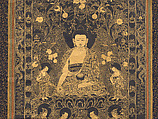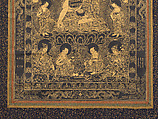On loan to The Met The Met accepts temporary loans of art both for short-term exhibitions and for long-term display in its galleries.
Śikhin, one of the Buddhas of the past
Not on view
In 1777, the Panchen Lama, high cleric of Tibet’s Tashilhunpo Monastery, sent a gift of seven paintings to the Qianlong emperor, each of which depicted one of the Buddhas of the past. As a sign of respect for this gift, Qianlong had them recreated in several forms: as polychrome paintings, as stone carvings, as rubbings of those stone carvings, and finally as paintings in gold on deep blue paper. This thangka, which depicts Śikhin, second of the seven Buddhas of the past, survives from a set of this final form, which transmutes the stark white on black visual idiom of the rubbing into a luxurious, shimmering gold on midnight blue. The painting is inscribed with a hymn in praise of Śikhin, which is rendered in the four official languages of the Qing court: Chinese, Manchu, Mongolian, and Tibetan. The poem reads:
Hymn to Śikhin
That which arises from good factors is fundamentally illusory;
That which creates evil karma, too, is fundamentally illusory.
With a body [ephemeral] like accumulated foam and a heart [diffuse] like wind,
He casts out illusions, which are rootless and without reality.
Due to rights restrictions, this image cannot be enlarged, viewed at full screen, or downloaded.
This artwork is meant to be viewed from right to left. Scroll left to view more.







